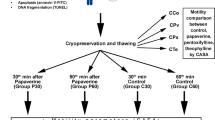Abstract
Purpose: Sperm collected by electroejaculation often showpoor motility. The objective was to determine whether theaddition of the phosphodiesterase inhibitor, pentoxifylline,would stimulate electroejaculated baboon sperm motility.
Methods: Electroejaculation was performed on severaloccasions on a male baboon and sperm collected afterfamiliarization. Pentoxifylline was tested at the standardconcentration (1 mg/ml) and at twice the concentration. Spermparameters were evaluated using a sperm motility analyzer,as well as acrosome and DNA integrity techniques.
Results: Sperm exposed to 2 mg/ml pentoxifylline had highertotal motility when compared with the control and 1 mg/mltreatment. Rapid progression and velocities were higher afterpentoxifylline. The acridine orange DNA normality testshowed that over 90;pc of collected sperm had intactunfragmented DNA. About half the sperm population had normalmorphology and intact acrosomes. A low percentage hadcytoplasmic droplets.
Conclusions: Sperm collected by rectal probeelectroejaculation required a higher concentration (2 mg/ml) ofpentoxifylline for enhanced total motility, rapid progression, andhigher velocity. This suggested differences in membraneproperties or phosphodisterase activity in electrojeaculatedsperm. The electroejaculation procedure did not denaturesperm DNA at the acridine orange assay level nor were theacrosomes disrupted. The present study also documentedunique information on baboon kinematic parameters.
Similar content being viewed by others
REFERENCES
Bornman MS, M van Vuuren, Meltzer DGA, van der Merwe CA, Rensburg SJ: Quality of semen obtained by electroejaculation from Chacma baboon (Papio ursinus). J Med Primatol 1987;17:57-61
Chowdury AK, Steinberger E: A study of germ cell morphology and duration of spermatogenic cycle in the baboon, Papio anubis. Anat Rec 1976;185:155-170
Rall WF: Cryobiology of gametes and embryos from nonhuman primates. In In Vitro Fertilization and Embryo Transfer in Primates. DP Wolf, RL Stoufer, M Brenner (eds). Springer-Verlag. Serono Symposium, 1993, pp 223-245
Hatasaka HH, Schaffer NE, Chenette PE, Kowalski W, Hecht BR, Meehan TP, Wentz AC, Valle RF, Chatterton RT, Jeyendran RS: Strategies for ovulation induction and oocyte retrieval in the lowland gorilla. J Assist Reprod Genet 1997;14:102-110
Gould KG, Warner H, Martin DE. Rectal probe electroejaculation of primates. J Med Primatol 1978;7:213-222
Chan PJ, Corselli JU, Jacobson JD, Patton WC, King A: Correlation between intact sperm acrosome assessed using the Spermac stain and sperm fertilizing capacity. Arch Androl 1996;36:25-27
Pang SC, Chan PJ, Lu A: Effects of pentoxifylline on sperm motility and hyperactivation in normozoospermic and normokinetic semen. Fertil Steril 1993;60:336-343
Tejada RI, Mitchell JC, Norman A, Marik JJ, Friedman S: A test for the practical evaluation of male fertility by acridine orange (AO) fluorescence. Fertil Steril 1984;42:87-91
Rees JM, Ford WCL, Hull MGR: Effect of caffeine and of pentoxifylline on the motility and metabolism of human spermatozoa. J Reprod Fertil 1990;90:147-156
Sikka SC, Hellstrom WJ: The application of pentoxifylline in the stimulation of sperm motion in men undergoing electroejaculation. J Androl 1991;12:165-170
World Health Organization: WHO Laboratory Manual for the Examination of Human Semen and Semen-Cervical Mucus Interaction, 3rd ed. Cambridge, England, The Press Syndication of the University of Cambridge, 1992
Glover TD, Barratt CLR, Tyler JPP, Hennessey JF: Human Male Fertility and Semen Analysis. New York, Academic Press, 1990
Wolf DP, Thomson JA, Zelinski-Wooten MB, Stouffer RL: In vitro fertilization-embryo transfer in nonhuman primates: Technique and its applications. Review article. Mol Reprod Dev 1990;27:261-280
Chan PJ, Hutz RJ, Dukelow WR: Nonhuman primate in vitro fertilization: Seasonality, cumulus cells, cyclic nucleotides, ribonucleic, and viability assays. Fertil Steril 1982;38:609-615
Bavister BD, Boatman DE, Leibfried L, Loose M, Vernon MW: Fertilization and cleavage of rhesus monkey oocytes in vitro. Biol Reprod 1983;28:983-999
Harrison RF: Insemination of husband's semen with and without the addition of caffeine. Fertil Steril 1978;29:532-534
Clayton O, Kuehl TJ: Successful in vitro fertilization and embryo transfer in a nonhuman primate. Theriogenology 1984;21:228-
Gorczyca W, Traganos F, Jesionowska H, Darzynkiewic Z: Presence of DNA strands breaks and increased sensitivity of DNA in situ to denaturation in abnormal human sperm cells: Analogy to apoptosis of somatic cells. Exp Cell Res 1993;207:202-205
Yanagimachi R. Mammalian fertilization. In The Physiology of Reproduction, 2nd ed, E Knobil, JD Neil (eds). New York, Raven Press, pp 189-317
Author information
Authors and Affiliations
Rights and permissions
About this article
Cite this article
CSEH, S., CHAN, P.J., CORSELLI, J. et al. Electroejaculated Baboon (Papio anubis) Sperm Requires a Higher Dosage of Pentoxifylline to Enhance Motility. J Assist Reprod Genet 17, 449–453 (2000). https://doi.org/10.1023/A:1009469319596
Issue Date:
DOI: https://doi.org/10.1023/A:1009469319596




